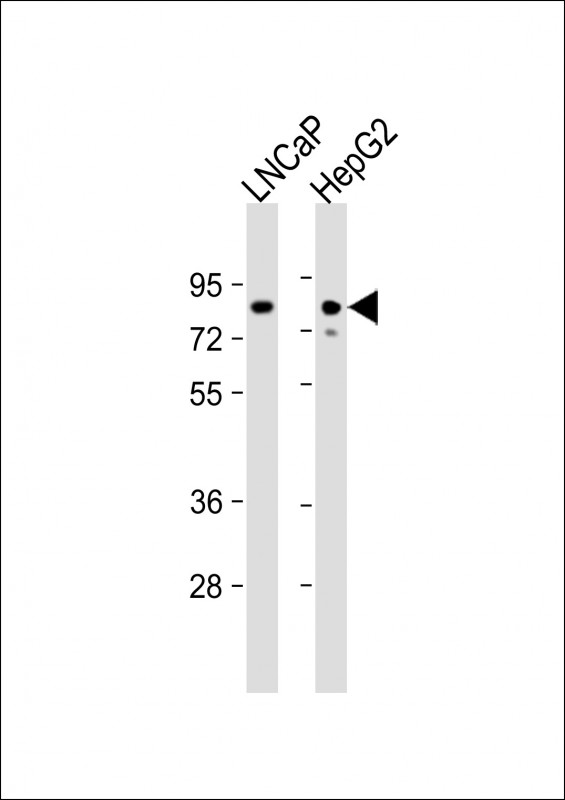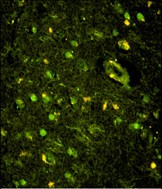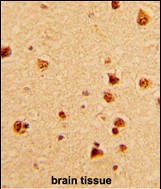


| WB | 1/1000 | Human,Mouse,Rat |
| IF | 咨询技术 | Human,Mouse,Rat |
| IHC | 1/100-1/500 | Human,Mouse,Rat |
| ICC | 技术咨询 | Human,Mouse,Rat |
| FCM | 1/10-1/50 | Human,Mouse,Rat |
| Elisa | 咨询技术 | Human,Mouse,Rat |
| Aliases | Far upstream element-binding protein 2, FUSE-binding protein 2, KH type-splicing regulatory protein, KSRP, p75, KHSRP, FUBP2 |
| Entrez GeneID | 8570 |
| WB Predicted band size | 73.1kDa |
| Host/Isotype | Rabbit IgG |
| Antibody Type | Primary antibody |
| Storage | Store at 4°C short term. Aliquot and store at -20°C long term. Avoid freeze/thaw cycles. |
| Species Reactivity | Human |
| Immunogen | This KHSRP antibody is generated from rabbits immunized with a KLH conjugated synthetic peptide between 94-122 amino acids from the N-terminal region of human KHSRP. |
| Formulation | Purified antibody in PBS with 0.05% sodium azide. |
+ +
以下是关于KHSRP(N-term)抗体的3篇参考文献的简要总结,包含文献名称、作者及摘要内容概括:
---
1. **文献名称**: *KSRP controls post-transcriptional regulation of inflammatory gene expression in macrophages*
**作者**: Lin WJ et al.
**摘要**: 本研究揭示了KHSRP通过结合促炎细胞因子(如TNF-α、IL-6)mRNA的3'UTR区域,促进其降解并抑制过度炎症反应。实验中利用KHSRP(N-term)抗体进行免疫印迹和RNA结合蛋白复合物的免疫沉淀,证实KHSRP在巨噬细胞中的RNA调控功能。
---
2. **文献名称**: *KH-type splicing regulatory protein interacts with let-7 precursor miRNA and regulates its stability*
**作者**: Trabucchi M et al.
**摘要**: 该研究证明KHSRP直接结合let-7前体microRNA,促进其由Drosha复合体加工成熟。通过KHSRP(N-term)抗体的免疫共沉淀实验,作者发现KHSRP在microRNA生物发生中的关键作用,并揭示其缺失导致let-7家族表达水平下降。
---
3. **文献名称**: *KHSRP regulates neuronal differentiation through mRNA stability control of NGF-responsive genes*
**作者**: Briata P et al.
**摘要**: 文章报道KHSRP通过调控神经生长因子(NGF)靶基因的mRNA稳定性,影响神经元分化。使用KHSRP(N-term)抗体的免疫荧光和Western blot分析显示,KHSRP在神经细胞中的亚细胞定位及其在分化过程中表达水平的变化。
---
如需具体文献链接或补充更多研究,可进一步提供关键词或领域细化。
The KHSRP (KH-type splicing regulatory protein) antibody, specifically targeting the N-terminal region, is a valuable tool for studying the multifaceted roles of KHSRP in RNA metabolism. KHSRP, also known as KSRP or FBP2. is an RNA-binding protein containing four KH domains that mediate interactions with AU-rich elements (AREs) in mRNAs. It acts as a post-transcriptional regulator, influencing mRNA stability, splicing, translation, and decay, often in collaboration with exonucleases like the exosome. KHSRP is implicated in pro-inflammatory cytokine production, cellular differentiation, and tumorigenesis, making it a focus in cancer, immunology, and neurodegeneration research.
The N-terminal-specific antibody recognizes epitopes within the first 100-200 amino acids of KHSRP, enabling detection of full-length protein while avoiding cross-reactivity with truncated isoforms or degradation products. It is widely used in techniques such as Western blotting, immunoprecipitation, and immunofluorescence to study KHSRP expression, localization, and interactions. Validated applications include investigating its role in miRNA biogenesis (via interactions with Drosha/DGCR8) and stress granule dynamics. Commercial antibodies are typically raised in rabbits or mice, with validation in knock-out cell lines to ensure specificity. Researchers favor this antibody for probing KHSRP's regulatory functions in cellular stress responses, viral infection pathways, and developmental processes linked to its RNA-binding activity.
×